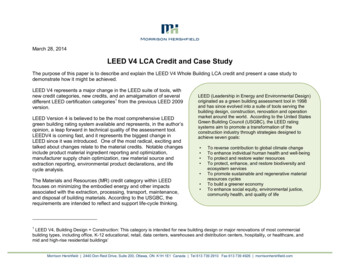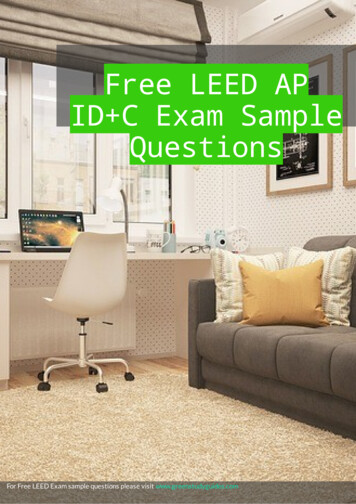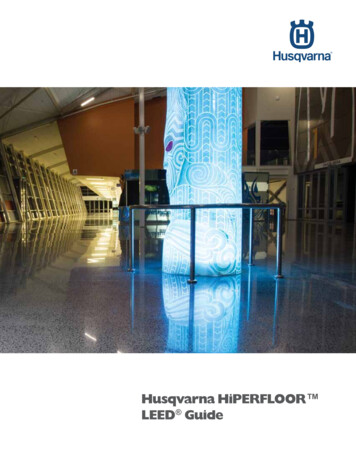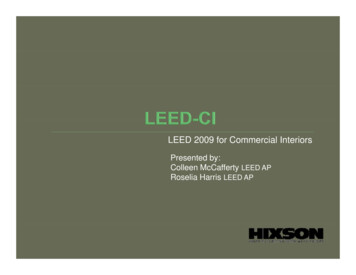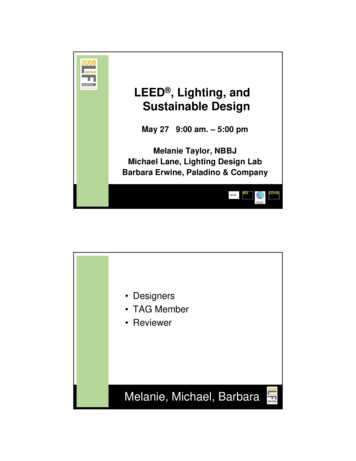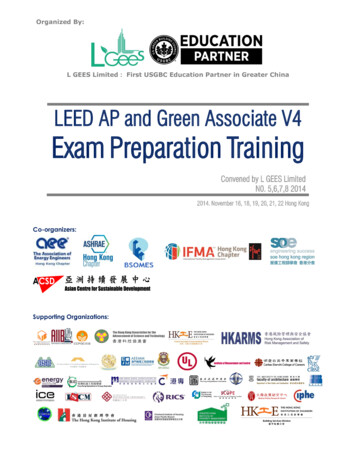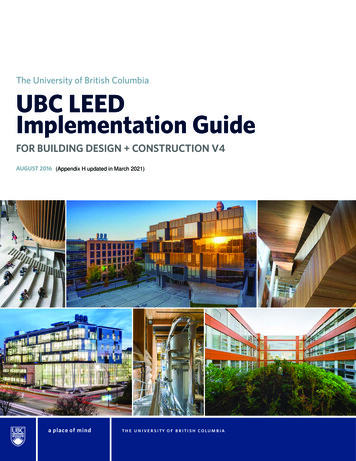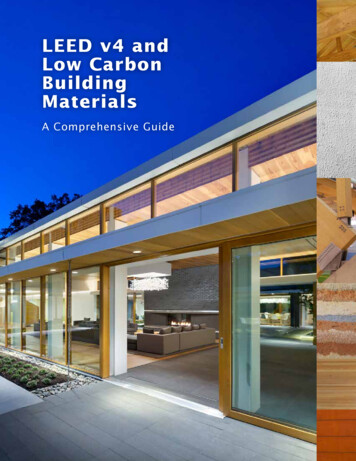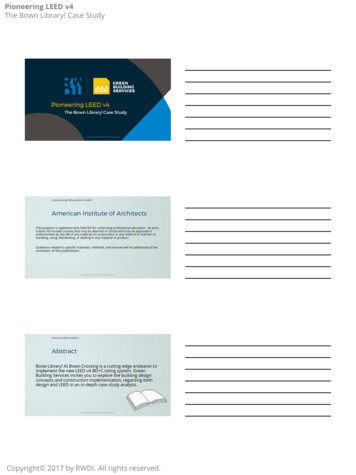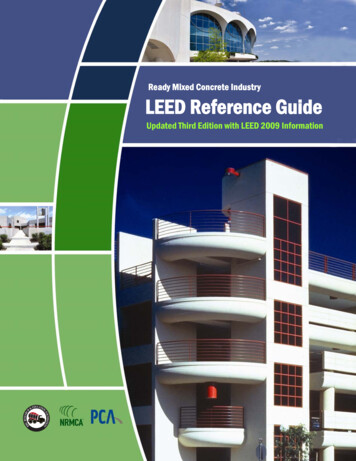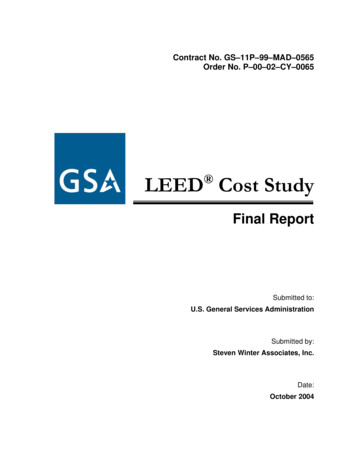
Transcription
Contract No. GS–11P–99–MAD–0565Order No. P–00–02–CY–0065 LEED Cost StudyFinal ReportSubmitted to:U.S. General Services AdministrationSubmitted by:Steven Winter Associates, Inc.Date:October 2004
ContentsAcknowledgements. iExecutive Summary. 1Introduction. 9Section 1:Twelve LEED Rating Scenarios . 18Section 2:Individual LEED Credit Reviews. 24Section 3:Synergistic Credit Reviews . 167Section 4:LEED-Related Soft Costs. 182Appendix ACost Estimate Summaries – Courthouse ScenariosAppendix BCost Estimate Summaries – Office Building ScenariosAppendix CIndividual Credit Cost Estimates – CourthouseAppendix DIndividual Credit Cost Estimates – Office BuildingAppendix ESynergistic Credit Cost Estimates – CourthouseAppendix FSynergistic Credit Cost Estimates – Office BuildingAppendix GSoft Cost Estimate SummariesAppendix HDetailed Soft Cost EstimatesAppendix IDOE-2 Energy Modeling Summary – CourthouseAppendix JDOE-2 Energy Modeling Summary – Office BuildingAppendix KReference Cost Estimate – CourthouseAppendix LReference Cost Estimate – Office Building, Minimal Façade RenovationAppendix MReference Cost Estimate – Office Building, Full Façade RenovationGSA LEED COST STUDY
AcknowledgementsThe authors of this report would like to thankMr. David B. Eakin, Chief Engineer in the Officeof the Chief Architect of the U.S. General ServicesAdministration, Public Buildings Service, for hisguidance, oversight, and support in conceptualizingand developing this study. Additional thanks areextended to the following individuals from the U.S.GSA Public Buildings Service for their support andcontributions: Donald Horn, EnvironmentalStrategies & Safety; Curt Smith, Office of the ChiefArchitect; Eric Cook, Office of the ChiefArchitect; Doug Pulak, Office of the ChiefArchitect; Robert Hixon, Office of the ChiefArchitect; Gianne Conard, Office of the ChiefArchitect; Bill Hunt, Office of the Chief Architect;Pam Wilczynski, Region 5; John Buckley, Region 1;John Morrell, Region 3; and Frank Saviano,Region 1.Cost estimating for the LEED Cost Study wasprovided by Skanska USA Building, Inc. (Atlanta,GA and Alexandria, VA offices). Elizabeth Heider,AIA, Vice President, was Project Manager for thisportion of the study. The Skanska project teamincluded Richard Leftwich, Susie Spivey, AndersonWelch, Darryl Wood, and Ray Fine.The GSA LEED Cost Study was prepared bySteven Winter Associates, Inc. (SWA) of Norwalk,Connecticut and Washington, DC. Helen Englishwas Principal-in-Charge of the study; JohnAmatruda was Project Manager and PrincipalAuthor. The SWA project team included BambiTran, Ian Graham, Charlotte Matthews, RussellTaylor, Jeff Rios, Doug Schlaefer, and Ben Dyson.The authors also extend thanks to Adrian Tuluca,SWA Principal, for his key insights and criticalreview.The authors are grateful to the followingindividuals and organizations for theircontributions to the landscape issues addressed inthe study: Brian Carlic of Payette Associates Inc.,Boston, Massachusetts; and Anne Guillette of theLow Impact Development Center, Inc., Beltsville,Maryland.GSA LEED COST STUDYIn addition, the authors would like to thank thefollowing individuals and organizations for theirinsights and contributions to the Soft Costs sectionof the study: Gina Baker and Scott Jones of BurtHill Kosar Rittelman Associates Architects,Washington, DC; Ron Cortes of the DickCorporation, Cleveland, Ohio; Monica Green ofvan Dijk Westlake Reed Leskosky, Cleveland,Ohio; and Ken Terzian of OPXArchitecture/Interiors, Washington, DC.i
Executive SummaryExecutive Summary:GSA LEED Cost StudyThe U.S. General Services Administration (GSA)commissioned this study to estimate the costs todevelop “green” federal facilities using the U.S.Green Building Council’s Leadership in Energy andEnvironmental Design (LEED) Building RatingSystem, Version 2.1. The report provides a detailedand structured review of both the hard cost andsoft cost implications of achieving Certified, Silver,and Gold LEED ratings for two GSA buildingtypes, using GSA’s established design standards asthe point of comparison.The two building types examined in the study are:1. A new mid-rise federal Courthouse (fivestories, 262,000 GSF, including 15,000 GSF ofunderground parking; base construction cost isapproximately 220/GSF)2. A mid-rise federal Office Buildingmodernization (nine stories, 306,600 GSF,including 40,700 GSF of underground parking;base construction cost is approximately 130/GSF).These building types reflect a significant percentageof GSA’s planned capital projects over the next fiveto ten years.Construction Cost ImpactsFor each of the two building types, baselineconstruction cost estimates were developed toGSA LEED COST STUDYreflect applicable federal design requirements, asdefined in GSA’s Facilities Standards for the PublicBuildings Service (document PBS-P100, 2003), and,for Courthouses, the Administrative Office of theUnited States Courts’ U. S. Courts Design Guide. Thedesign standards were also used as the basis forevaluating each LEED prerequisite and credit. Ananalysis was performed to identify green buildingmeasures—above and beyond those included inGSA’s standards—that would likely beimplemented to meet the specific LEEDprerequisite and credit requirements. From thesemeasures, cost impact estimates were developed foreach prerequisite and credit, with variations definedfor both the Courthouse and Office Buildingmodels. The individual credit costs were alsocategorized, using the following key:1. GSA mandate (no cost)2. No Cost/Potential Cost Decrease3. Low Cost ( 50K)4. Moderate Cost ( 50K- 150K)5. High Cost ( 150K)From these individual credit assessments, overallproject cost estimates were developed for 12 LEEDrating “scenarios” (6 for each building type). Thescenarios were defined as follows: New Courthouse. Two estimates were developedat the Certified, Silver, and Gold rating levels.At each rating level, one “low cost” and one1
Executive Summary “high cost” scenario was defined in order tobracket the LEED costs.used as the basis for bracketing the LEEDOffice Building costs.Office Building Modernization. Two estimateswere developed at the Certified, Silver, andGold rating levels. At each rating level, onescenario reflected a “minimal façaderenovation” (window replacement, minorrepairs) and the other reflected a “full façaderenovation” (new cladding and façade design,new windows, new insulation). The differentfaçade scenarios reflect one of the mostsignificant scope variations in GSA’smodernization projects and were thereforeThe point totals used for each rating level were asfollows: 28 points for a Certified rating, 35 pointsfor a Silver rating, and 41 points for a Gold rating.These totals are purposely 2 points higher than theLEED minimums, as it is common practice tosubmit additional credits to ensure that a rating isachieved (i.e., in the case that one or two credits aredenied during the LEED certification process withthe USGBC).The construction cost impacts for the 12 ratingscenarios are identified in Tables ES-1A andES-1B.NEW COURTHOUSETABLE ES-1A(262,000 GSF, Base Construction Cost 220/GSF)CertifiedSilverGold1A2A3A4A5A6ALow CostHigh CostLow CostHigh CostLow CostHigh Cost /GSF( 0.76) 2.18( 0.07) 9.57 2.97 17.79% CHANGE-0.4%1.0%-0.03%4.4%1.4%8.1%LEED CONSTRUCTION COST IMPACTS*OFFICE BUILDING MODERNIZATIONTABLE ES-1B(306,600 GSF, Base Construction Cost 130/GSF)CertifiedSilverGold1B2B3B4B5B6BMin. FacadeFull FacadeMin. FacadeFull FacadeMin. FacadeFull Facade /GSF 1.78 2.73 3.94 5.55 10.58 10.22% CHANGE1.4%2.1%3.1%4.2%8.2%7.8%LEED CONSTRUCTION COST IMPACTS** Construction cost estimates reflect a reference date of October 2003 (GSA FY04) and a reference location of Washington, DC.The construction cost estimates reflect a number ofGSA-specific design features and projectassumptions; as such the numbers must be usedwith caution. The cost impacts may not be directlytransferable to other project types or buildingowners. These issues are reviewed in greater detailin the “Cost Estimate Qualifiers” section below.GSA LEED COST STUDY2
Executive SummarySoft Cost ImpactsSoft costs were also evaluated based on twodifferent design team approaches. In the “ExpertConsultant” approach, the design team works withspecialized “green building” consultants, who guidethe LEED process and perform a number ofLEED-specific tasks. In the “ExperiencedDesign/Construction Team” approach, all LEEDtasks are performed by the core design andconstruction management teams, who haveprevious LEED project experience.Soft cost impacts were defined for LEED-relatedtasks that were above and beyond standard GSAproject requirements. Tasks were defined in twocategories: LEED Design Costs: Those tasks that increasethe design team’s scope of work during thedesign and construction stages of a projectLEED Documentation Costs: Those tasksassociated with documenting and submitting aLEED application to the U.S. Green BuildingCouncil.The soft cost impacts for the twelve ratingscenarios are identified in Tables ES-2A andES-2B.As with the construction cost analysis, soft costimpacts were defined for six Courthouse and sixOffice Building rating scenarios.NEW COURTHOUSETABLE ES-2A(262,000 GSF, Base Construction Cost 220/GSF)CertifiedSilverGold1A2A3A4A5A6ALow CostHigh CostLow CostHigh CostLow CostHigh CostEXPERT CONSULTANT APPROACH( /GSF) 0.41 0.46 0.41 0.55 0.61 0.80EXPERIENCED DESIGN TEAM APPROACH( /GSF) 0.43 0.45 0.44 0.54 0.56 0.73LEED SOFT COST IMPACTSOFFICE BUILDING MODERNIZATIONTABLE ES-2B(306,600 GSF, Base Construction Cost 130/GSF)CertifiedSilverGold1B2B3B4B5B6BMin. FacadeFull FacadeMin. FacadeFull FacadeMin. FacadeFull FacadeEXPERT CONSULTANT APPROACH( /GSF) 0.41 0.41 0.44 0.49 0.70 0.69EXPERIENCED DESIGN TEAM APPROACH( /GSF) 0.35 0.35 0.38 0.44 0.59 0.58LEED SOFT COST IMPACTSAs with the construction cost estimates, the softcost estimates reflect a number of GSA-specificproject assumptions. As such, the numbers mustbe used with caution.GSA LEED COST STUDY3
Executive SummaryThe cost impacts may not be directly transferable toother project types or building owners. These issuesare reviewed in greater detail in the “Cost EstimateQualifiers” section below.Cost Estimate QualifiersThe cost impacts derived in the study are subject toa number of qualifiers, which are important inunderstanding how the costs may relate to otherbuilding types, building sizes, and non-GSAprojects. Key qualifiers are reviewed as follows:many “market-rate” commercial developments. Anumber of GSA’s design criteria are consistent withLEED credit requirements and therefore assist theirprojects in earning LEED points. For the purposesof this study, these features or practices are notconsidered part of the LEED premium.Conversely, in a few cases, GSA’s policies andpractices limit the applicability of LEED creditsthat might be more easily included in non-GSAprojects. Some of the most significant GSA-specificcriteria are listed as follows: 1. Building Program and Site AssumptionsThe specific programmatic requirements of theCourthouse and Office Building play an importantrole in determining the applicable LEED creditsand the resulting LEED cost impacts. Significantlydifferent building types (e.g., laboratories, schools,and residential buildings) would likely develop adifferent overall profile of LEED credits, and mightuse significantly different approaches to achievecommon credits. The programmatic differences between newconstruction (Courthouse) and renovation (OfficeBuilding) also factor into the credit selections andresulting costs. The program for the OfficeBuilding, for example, does not include siterenovation or roof replacement, based on typicalGSA modernization scopes. This significantly limitsthe number of LEED site credits available in theOffice Building model, as compared to the newconstruction Courthouse.The scenarios in the study are also subject to anumber of specific site assumptions (e.g., urbanlocations, brownfield redevelopment, no abovegrade parking, large site acreage for the Courthousebased on security setbacks). As with theprogrammatic assumptions, these specific sitecharacteristics determine the feasibility of a numberof the LEED credits. Buildings in suburban or ruralsettings, for instance, would develop a differentprofile of credits in the Sustainable Sites category,which would result in different cost impacts inthose areas.2. GSA-Specific Design RequirementsIn addition to the general programmatic and siteissues discussed above, GSA’s comprehensivedesign criteria differentiate their projects fromGSA LEED COST STUDY Commissioning. GSA already requires a totalbuilding commissioning process for its projectsand therefore does not consider it to be aLEED cost. For the purposes of this study,GSA’s commissioning efforts are assumed toearn both the LEED commissioningprerequisite and credit EA-3, AdditionalCommissioning.Energy efficiency. GSA sets energy performancetargets for their buildings, which are typicallymore stringent than local energy codes or theASHRAE standard 90.1-1999, which is used asthe baseline in LEED. For the Courthouse, atarget of 45,000 to 50,000 BTU/GSF/year wasset, which translated to 1 LEED point(approximately a 17 percent improvement)under LEED credit EA-1. Similarly, the OfficeBuilding modernization started with an energyuse target of 50,000 to 55,000 BTU/GSF/year,which translated to 2 LEED points(approximately a 14 percent improvement) inthe minimal façade renovation case, and 3LEED points (approximately an 18 percentimprovement) in the full façade renovationcase.Underfloor air delivery system. For newconstruction projects, GSA’s P100 (2003)encourages the use of underfloor air deliverysystems in appropriate applications. In theCourthouse model of this study, an underfloorair system has been included in the base costs.The system allowed the building to earn creditEQ-2 (Ventilation Effectiveness) and assistedin earning credit EQ-6.2 (Increased OccupantControl).Dedicated ventilation system. GSA’s P100 (2003)requires dedicated outside air ventilation unitsfor both perimeter and interior spaces. Thisdesign approach is used to provide greater4
Executive Summary control of outside air and to maintain positivepressure in perimeter spaces to reduce thepotential for moisture/condensation buildup inexterior wall assemblies. For the purposes ofthis study, the dedicated ventilation system wasassumed to be eligible for a LEED Innovationcredit.Recycled-content materials. GSA projects arerequired to incorporate recycled contentmaterials, to the maximum extent feasible, asidentified in the U.S. Environmental ProtectionAgency’s (EPA) Comprehensive ProcurementGuidelines (CPG). Recycled-content productslisted in the CPG include concrete (with flyashor blast furnace slag), building insulations,carpets and carpet cushions, and shower ortoilet partitions. The study assumes that all ofthe applicable CPG product types are used inthe Courthouse and Office Building models,assisting the scenarios to achieve credits MR4.1 and 4.2 (Recycled Content). It should benoted that many of the CPG products could beincorporated into non-GSA projects at no costpremium.HCFC refrigerants. LEED credit EA-4 prohibitsthe use of HCFCs or Halons in building-levelHVAC, refrigeration, or fire-suppressionsystems. GSA’s P100 defines acceptable HVACrefrigerants through the EPA’s Significant NewAlternatives Policy (SNAP). The SNAPalternatives currently include HCFC-22;therefore, GSA does not rule out the use of thisrefrigerant on any project. Because of thispolicy, credit EA-4 has not been included inany of the Courthouse or Office Buildingscenarios.Green power. LEED credit EA-6 can be earnedby purchasing electricity generated fromrenewable resources such as wind, solar, orbiomass (the credit defines the amount ofelectricity that must be purchased and itscertification). Although GSA does purchasegreen power for some of its facilities, thedetermination is made by regional managers ona case-by-case basis. Overall, the credit wasconsidered an operational issue outside of thescope of this study. Credit EA-6 has not beenincluded in any of the Courthouse or OfficeBuilding scenarios.GSA LEED COST STUDYAdditional design criteria issues are reviewed in the“Individual Credit Reviews” section of the study.3. No Programmatic Trade-offsFor the purposes of the study, no programmaticadjustments were made between the LEED andnon-LEED buildings; i.e., space allocations werenot adjusted, material finishes were kept consistent,glazing areas remained the same, etc. In someLEED projects, these types of programmatic tradeoffs can be used to offset increases in first costderived from high-performance buildingcomponents (e.g., better quality glazings, moreefficient HVAC equipment, and formaldehyde-freecasework). Although this approach can be aneffective means of cost control, it was purposelynot pursued in the study. The intent of the studywas to identify potential LEED cost impacts basedon identical programmatic requirements.The one exception to this rule that occurs in thestudy is in site development. As there is often adegree of flexibility to the site and landscapingprograms in GSA projects, adjustments have beenallowed in site paving areas, planting areas, andirrigation systems in order to achieve variousLEED credits in the Sustainable Sites and WaterEfficiency categories.4. Building SizeThe study has identified cost impacts for two midrise buildings of approximately 260,000 to 300,000gross square feet. The scope of the study did notinclude an evaluation of how the costs may vary forbuildings that are significantly smaller or larger thanthese mid-rise models. It is generally assumed thatsome adjustments would be required. The soft costestimates in particular are assumed to be verysensitive to the project scale, with the /grosssquare foot (GSF) fees becoming significantlyhigher in smaller buildings and correspondinglylower in larger projects. The total dollar costs forLEED-related services are expected to level outafter they cross certain “low end” and “high end”thresholds.5. Variations in Baseline Project CostsThe building program, site assumptions, and designcriteria determine the baseline project costs for thetwo models. The differences in the baseline costs( 220/GSF for the Courthouse versus 130/GSF5
Executive Summaryfor the Office Building Modernization) areimportant to note, because they directly influencethe percentage-based calculations of LEED costimpacts. For example, LEED-based measures thathad similar total costs in the two projects (e.g.,water-efficient plumbing fixtures, carbon dioxidesensors) have significantly different impacts as apercentage of the total project costs. It is thereforeimportant to consider both the /GSF andpercentage-based impacts when evaluating theoverall LEED costs.6. Costs Based on LEED Version 2.1All credit cost assumptions are based on LEEDVersion 2.1, which was the current rating system atthe time of the study. As LEED is a constantlyevolving program, new versions are expected in thenear future (versions 2.2 and 3.0 are already inprogress, with projected release dates in 2005 and2006, respectively). While the specific changes toLEED are unknown at the time of this report, it isexpected that the new versions will warrantadjustments to the cost impacts derived in thestudy.Because of these varying cost estimate qualifiers,simple cost extrapolations from the overall resultsof the study cannot be considered reliable forprojects of significantly different scope or scale.However, the detailed cost breakdowns included inthe study can provide a basis for other projects toevaluate LEED costs. The “apples to apples”comparisons of the Individual Credit Reviews andCost Estimates (Section 2 and Appendices C andD) can serve as a starting point in understandingthe typical scope and potential cost implications ofvarious LEED measures. Additionally, the soft costsummaries and breakdowns included in Section 4and Appendices G and H can provide a basis forunderstanding the extent and costs of LEEDrelated professional services.Addressing LEED Cost VariablesThe study indicates that there is an inherent degreeof variability to LEED construction cost impacts.The primary factors creating this variability includethe following:1. There is no correlation between the pointvalue of a LEED credit and its cost. There aremany “no cost” and “low cost” LEED credits (suchGSA LEED COST STUDYas development density, proximity to publictransportation, no irrigation systems, use of locallymanufactured materials, low-VOC adhesives, lowemission carpets) that earn 1 point each. At theother extreme, the study illustrates that some credits(renewable energy, for example) can cost hundredsof thousands of dollars each—and still earn 1 point.The selection of credits used to achieve a LEEDrating can therefore result in a wide range ofresultant costs.2. A range of different strategies can often beused to earn the same individual LEED credit.Many of the LEED credit criteria are performancebased rather than prescriptive. This allows designteams flexibility in defining an approach to creditcompliance. Different strategies can also result insignificantly different cost impacts. An examplefrom the cost study is credit SS-6.1, StormwaterManagement (Rate and Quantity), used in theCourthouse model. In the “low cost” scenarios, thecredit was earned by increasing the amount of siteplantings and reducing the amount of site paving.This approach actually reduced construction costs.In one of the “high cost” Gold rating scenarios, avegetated roof system was installed as an alternativeapproach. The premium for the vegetated roofsystem was approximately 580,000. While thevegetated roof has additional benefits and was usedto earn an additional LEED credit (SS-7.2, HeatIsland Reduction), it still represented a significantlymore expensive approach to credit compliance.3. The cost of some credits varies significantlybased on the building type and buildingprogram. For example, in the Office Buildingmodel, earning credit MR-7 (Certified Wood)involved a moderate cost premium (approximately 77,000) because wood use in the building waslimited (some doors and a small amount ofcasework). In the Courthouse model, on the otherhand, the cost premium to earn the credit wasalmost 600,000. The Courthouse has extensivewood finishes, including paneling, doors, casework,and fixed furnishings in the courtrooms and judges’chambers.4. Some credit costs vary based on regionspecific or project-specific issues. Two examplesillustrate this point. In some parts of the country,earning and exceeding the requirements of creditsMR-5.1/5.2 (Local/Regional Materials) can beeasily accomplished at no cost. In other locations, a6
Executive Summarypremium may be paid to use brick, stone, or othermajor construction materials that are locallymanufactured or sourced. A second exampleinvolves credit MR-2.1/2.2 (Construction WasteManagement). Costs to earn this credit can varysignificantly depending on the recyclinginfrastructure in the region, the experience of thecontractors and construction/demolition crews,and the space constraints of the project site.Overall, the study illustrates that when GSAprojects take advantage of many “no cost” or “lowcost” credit opportunities, the overall constructioncost premium can be surprisingly limited, even atthe higher rating levels. Under certain conditions, itis even possible for projects to show a slight costdecrease. However, when few low-cost credits areavailable to a project, the premiums increasesignificantly. The level of variability is most clearlyillustrated in the Gold rating scenarios of theCourthouse model, which ranged from only a 1.4percent premium in the “low cost” case(approximately 3.00/GSF) to an 8.1 percentpremium (almost 18/GSF) in the “high cost” case.By contrast, the cost premiums for the OfficeModernization model showed much less variationat each rating level. This was intentional to a largedegree, because the cost bracketing was basedprimarily on one issue (the impact of the differentfaçade renovations) rather than on the more diverse“low cost vs. high cost” approach used for theCourthouse. The Office Building model alsodemonstrated, however, that when the choice ofLEED credits is more limited, the cost premiumstend to be more predictable. The Office Buildingmodel had fewer credits to choose from becausethe scope of work did not include site renovationsor roof replacement, which limited the number ofapplicable Sustainable Sites and Water Efficiencycredits.Beyond the issue of cost variations, the broaderimplication derived from the Courthouse andOffice Building models is that GSA’s green buildingcosts can be managed, and to some degreepredicted, if a consistent approach is applied fromproject to project. A structured approach to LEEDwould include the following steps: Identify and incorporate all LEED credits thatare “automatically” earned based on GSAdesign standards.GSA LEED COST STUDY Identify and incorporate those LEED creditsthat can be earned at no cost or minimal costbased on the particular site conditions andprogrammatic requirements of the project. Evaluate and incorporate appropriate no-costor minimal-cost LEED credits. Examplesinclude items such as water efficiency(plumbing fixtures) or low-emission paints,adhesives, and sealants. Many of these creditsdo not affect the project design but ratherinvolve product selection and specificationissues. Evaluate and select appropriate credits at themoderate and high-cost levels. Analysis ofthese credits should weigh first costs againstthe immediate and long-term value of themeasures (e.g., lower operating costs,improved workplace environment, significantcommunity or environmental benefits). At thislevel, a strong emphasis should be placed onidentifying and exploiting inter-creditsynergies.An analysis of this type, performed early in thedesign process, can provide clear direction to adesign team and help establish realistic LEEDgoals. In addition, the analysis can help teamsidentify the significant design and performancechallenges for a project, which require integratedthinking and full team participation. These designrelated issues often have the most significantimpacts on cost and performance (e.g., approachesto daylighting, energy efficiency, stormwatermanagement) and therefore require an early focus.This structured approach is the basis of GSA’sLEED Applications Guide, the companion documentto the LEED Cost Study. The Applications Guideprovides a more detailed review of the process andissues outlined above.Implications for GSA ProjectsGSA’s P100 requires all new construction andmajor modernization projects to be certifiedthrough the LEED program, with an emphasis onobtaining Silver ratings. Individual client agenciesmay also work with GSA to pursue even higherlevels of LEED certification. Using the results ofthe LEED Cost Study, the GSA intends to refinethe amount of “sustainability” funding provided forfuture projects (prior to the Cost Study, GSA has7
Executive Summaryallocated a 2.5% budget increase for green buildingconstruction costs). The new budget allocation willbe enough to ensure that projects can achieveLEED Certified ratings; however, project teams willbe encouraged to achieve the highest level ofLEED rating that is practical within the overallbudget. With the revised budget allotments (whichwill likely vary between 2.5% and 4.0%, dependingon the project), the study indicates that many Silverrated buildings should be possible, as well asoccasional Gold rated projects.The opportunity to achieve Silver ratings or higheris also supported by GSA’s general projectcontingencies and by the accuracy allowances of thecost estimates themselves. As illustrated in FigureES-1, the range of estimated construction costimpacts for the Certified and Silver rated scenariosfalls below the 5% estimating accuracy that wouldnormally be expected of early conceptual estimates.In addition, the construction cost impacts for all ofthe rated scenarios, including Gold, fall below the10% design contingency that is carried in mostGSA project budgets at the concept phase. Thesenumbers imply that in some scenarios (dependingon the design solution, market conditions, andother contingency factors), a LEED rating couldpotentially be achieved within a standard GSAproject budget (without a green building budgetallowance). By including a dedicated green buildingallowance, the potential for GSA buildings toachieve higher LEED rating levels - with theattended benefits - is substantially greater.FIGURE ES-1GSA LEED Construction Cost Impacts vs. Estimating Accuracy and Design atingAccuracy6.0%Previous GSABudget Allocationfor LEED (2.5%)4.0%5.0%3.0%2.0%1.0%0.0%-1.0%C ertifiedS ilverCourthouseGSA LEED COST STUDYGoldC ertifiedS ilverGoldOffice Building8
IntroductionI
Consultant” approach, the design team works with specialized “green building” consultants, who guide the LEED process and perform a number of LEED-specific tasks. In the “Experienced Design/Construction Team” approach, all LEED tasks are performed by the core design and construction management t

